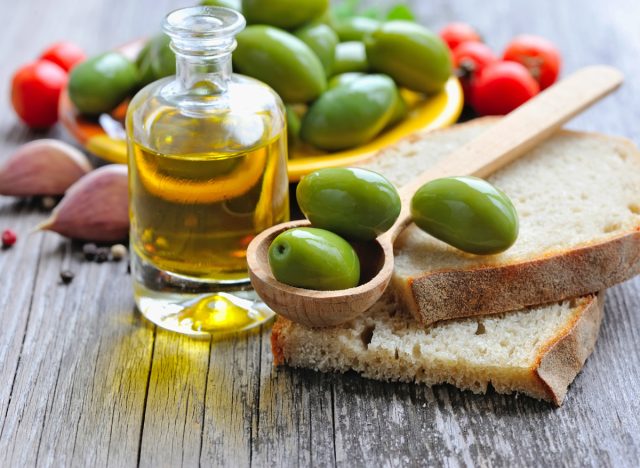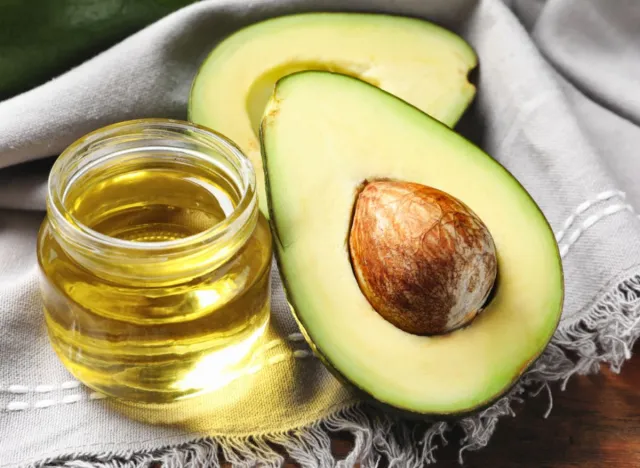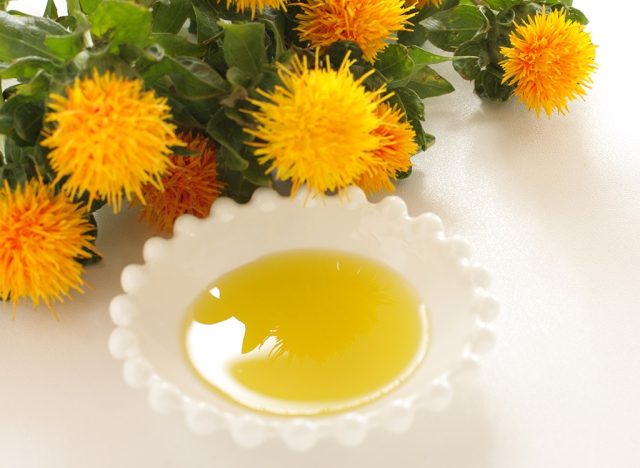What Is the Best Oil for Cooking?
Back in the 1980s, fat was thought to be “bad” for our health. Low-fat and nonfat products, from cookies to chips, lined market shelves. Lo and behold, the research didn’t back up that all fat is unhealthy, but rather the type of fat.
The macronutrient lipids (aka fats) are divided into two main categories: saturated and unsaturated. The names describe the number of single or double bonds that the fat molecule has. Fatty acids contain hydrocarbon chains, and if there are only single bonds evident between the carbons within a given hydrocarbon chain, the fat is considered saturated. If there are double bonds within a hydrocarbon chain, it’s an unsaturated fat.
Research has shown that saturated fat increases the risk of atherosclerosis, which is the hardening of the arteries due to plaque buildup. This buildup increases the risk of heart disease, including heart attacks and strokes. That is why the 2020–2025 Dietary Guidelines for Americans recommends no more than 10% of total calories come from saturated fat. You can find saturated fat in butter, lard, the skin of the chicken, and fatty cuts of meat.
The other type of fat is called unsaturated, and it is considered to be the healthy type of fat. Unsaturated fat can further be broken down into monounsaturated (the molecule has one double bond) and polyunsaturated (the fat molecule has two or more double bonds).
According to the American Heart Association, monounsaturated fat can help reduce LDL (“bad”) cholesterol which can help lower your risk of heart disease and stroke. In addition, monounsaturated fat provides nutrients to help develop and maintain the body’s cells. Oils high in monounsaturated fat also provide the antioxidant vitamin E. Monounsaturated fat is found in olive, canola, avocado, peanut, safflower, and canola.
Polyunsaturated fat can also help reduce the LDL (“bad”) cholesterol levels in your blood and help lower the risk of heart disease and stroke. Polyunsaturated oils also contribute the antioxidants vitamin E, which most Americans need more of. Oils high in polyunsaturated fats also provide essential fats that your body can’t produce but need, including omega-6 and omega-3 fatty acids. These two essential fats have many important functions in the body. Oils that provide polyunsaturated fat include soybean, corn, and sunflower oil.
The 2020–2025 Dietary Guidelines recommend choosing healthy fats, meaning the unsaturated kind. This means choosing cooking oil that provides unsaturated fat. Although I love all kinds of unsaturated oils, the one that tops my list for cooking is olive oil—and here is why.
The Best: Olive Oil

What is olive oil?
“Olive oil is simple, natural food. It’s produced by crushing the fruit of the olive and separating the oil from the pulp—the same way it’s been made for millennia,” explains Joseph R. Profaci, executive director of the North American Olive Oil Association. “For virgin olive oils (virgin means unrefined), no high heat is used to aid in separating the oil from the pulp. For regular or light-tasting olive oil, which is made of refined olive oil and virgin olive oil, sometimes heat is used in the extraction process. But chemical solvents are never used in the extraction of any grade of olive oil.”
What are the nutritional benefits of olive oil?
Profaci explains that a substantial portion of the nutrition benefits are from the fatty acid composition, especially of oleic acid. The approved FDA-qualified health claim for olive oil and cardiovascular health is based on its oleic acid content. All olive oils, including extra virgin, regular, and light-tasting, have the same fatty acid content, which is high in oleic acid and low in saturated fat.
“More and more research, however, has established the benefits of the naturally occurring olive polyphenols in extra virgin olive oil,” says Profaci. “The European Food Safety Agency (the European equivalent of FDA) has approved a health claim for olive oils that contain 5 milligrams of polyphenols per 20 grams of olive oil (specifically hydroxytyrosol), which is associated with protecting blood lipids from harmful oxidation.”
A breakdown of olive oil’s fat composition
- Monounsaturated: 72%
- Polyunsaturated: 8%
- Saturated: 13%
What to know about cooking with olive oil
Olive oil is versatile in the kitchen. Also, “contrary to urban myth, you can cook with all olive oils, even extra virgin,” says Profaci.
If you want a neutral-tasting oil, choose regular or light-tasting olive oil. All types can safely be used for braising, sautéing, baking, and frying. It can also be used in dressings and marinades.
Olive oil’s average smoke point: 390–468°F
Runner Up: Avocado Oil

What is avocado oil?
Avocado oil is extracted from the flesh of pressed avocados. It has a mild taste and high smoke point, making it perfect for cooking oil. Avocado oil, however, can also be used raw. The oil has a green tint which comes from carotenoids and chlorophyll. Avocado is typically compared to olive oil as they are both rich in fatty acids, specifically oleic acid.
What are the nutritional benefits of avocado oil?
Because it is high in monounsaturated fat, avocado oil is considered heart-healthy. It helps the body absorb fat-soluble vitamins and also provides the antioxidant vitamin E. Avocado oil also contains lutein, which has been linked to eye health—specifically to help protect against age-related macular degeneration, an age-related eye disease.
A breakdown of avocado oil’s fat composition
- Monounsaturated: 69.4%
- Polyunsaturated: 16.6%
- Saturated: 14%
What to know about cooking with avocado oil
Due to its high smoke point, you can cook on a stovetop with avocado oil (and even fry!) It can also be used in marinades and dressings, added to smoothies, or anywhere else you would like to add a touch of oil.
Avocado oil’s average smoke point: Close to 500°F
Runner Up: Canola Oil

What is canola oil?
Canola belongs to the Brassica family, along with mustard, broccoli, cauliflower, and Brussels sprouts. This oil is extracted by slightly heating the crushed tiny black canola seeds, which comprise about 45% oil. The oil has a high smoke point and neutral taste, making it a favorite for cooking and baking.
What are the nutritional benefits of canola oil?
Canola oil is high in monounsaturated fat, which has been shown to help lower “bad” cholesterol (LDL). The FDA authorized the health claim that 1½ tablespoons of canola oil per day may reduce the risk of coronary heart disease when used in place of saturated fat. It is also high in ALA omega-3 fats, which is an essential fatty acid the body needs. Canola oil is an excellent source of vitamin K and vitamin E, providing 20% and 16% of the daily recommended amount, respectively.
A breakdown of canola oil’s fat composition
- Monounsaturated: 58%
- Polyunsaturated: 29%
- Saturated: 7%
What to know about cooking with canola oil
Canola oil is ideal for almost any type of cooking you want to do. It can be used for sauteing, frying, and baking but can also be used uncooked in marinades and dressings. This oil can also be used in baking recipes as it has that neutral flavor.
Canola oil’s average smoke point: 435–445°F
Runner Up: Safflower Oil

What is safflower oil?
This oil comes from the seeds of the safflower plant. It has a mild flavor and has a high smoke point.
What are the nutritional benefits of safflower oil?
Safflower oil provides close to 75% linoleic acid, an essential fatty acid that your body cannot make. Research shows that linoleic acid may help lower blood cholesterol and has been linked with improved heart and circulatory conditions.
A breakdown of safflower oil’s fat composition
- Monounsaturated: 12%
- Polyunsaturated: 74%
- Saturated: 9%
What to know about cooking with safflower oil
Due to its high smoke point, it can be used on stovetops and even for frying. It can also be used in salad dressings as well as for baking.
Safflower oil’s average smoke point: 255–510°F
- Source: https://bio.libretexts.org/Bookshelves/Introductory_and_General_Biology/Book%3A_General_Biology_(Boundless)/03%3A_Biological_Macromolecules/3.03%3A_Lipid_Molecules_-_Introduction#:~:text=1%3A%20Fatty%20Acids%3A%20Saturated%20fatty,one%20or%20more%20double%20bonds.
- Source: https://pubmed.ncbi.nlm.nih.gov/34649831/#:~:text=A%20diet%20high%20in%20saturated,(LDL%2DC)%20concentration.
- Source: https://www.dietaryguidelines.gov/sites/default/files/2020-12/Dietary_Guidelines_for_Americans_2020-2025.pdf
- Source: https://www.heart.org/en/healthy-living/healthy-eating/eat-smart/fats/monounsaturated-fats#:~:text=How%20do%20monounsaturated%20fats%20affect,and%20maintain%20your%20body's%20cells.
- Source: https://www.heart.org/en/healthy-living/healthy-eating/eat-smart/fats/polyunsaturated-fats
- Source: https://www.hsph.harvard.edu/nutritionsource/what-should-you-eat/fats-and-cholesterol/types-of-fat/
- Source: https://www.ncbi.nlm.nih.gov/pmc/articles/PMC6600360/#:~:text=Studies%20carried%20out%20in%20South,%25%20and%2014%25%2C%20respectively.
- Source: https://books.google.com/books?id=8Lyrh2JXWuoC&printsec=frontcover&dq=What+Einstein+Told+His+Cook;+Kitchen+Science+Explained&hl=en&sa=X&ved=0ahUKEwicqqygzcnPAhWEjz4KHdsvAv0Q6AEILzAD#v=onepage&q=smoke%20point&f=false
- Source: https://www.jonbarron.org/diet-and-nutrition/healthiest-cooking-oil-chart-smoke-points










